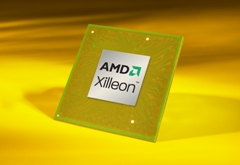
Con il comunicato stampa di seguito allegato AMD ha presentato al grande pubblico una nuova linea di processori, chiamata Xilleon e concepita per l'impiego nei televisori digitali realizzati mediante l'ausilio della tecnologia liquid crystal display (LCD).
La nuova gamma di processori di AMD ora include i chip siglati Xilleon 410, 411, 420 e 421: questi sono stati progettati "per garantire un elevata qualità dell'immagine e supportare la tecnologia Full HD (1080p)". Il costruttore mette in rilievo la versatilità dei nuovi prodotti, capaci di "rispondere alle esigenze dettate dalle differenti categorie di appartenenza degli LCD e di ridurre, parimenti, i costi di produzione".

[Immagine ad alta risoluzione]

SUNNYVALE, Calif. -- January 7, 2008 --AMD (NYSE: AMD) today unveiled a new family of AMD Xilleon panel processors designed to provide unrivaled visual quality in liquid crystal display (LCD) digital TVs. AMD’s new panel processors deliver advanced motion compensation and frame rate conversion technology for excellent image processing, resulting in a rich, immersive entertainment experience.
“The visual experience now defines the user experience. We are committed to helping manufacturers deliver crystal clear ‘20/20 television’ to a growing mainstream market of digital TV consumers worldwide, enabling The Ultimate Visual Experience,” said Dave Di Orio, corporate vice president and general manager, AMD’s DTV division. “AMD is driving innovation and design efficiencies with outstanding technology in highly integrated, flexible AMD Xilleon processor solutions, which now span from TV motherboards to display panels.”
As consumers demand ever larger TVs with greater visual clarity, such as that offered by full high-definition (1080p) technology, the appearance of picture defects such as blurred motion, or jerky movements referred to as “film judder”, can detract from the viewing experience and leave consumers dissatisfied with their TV purchase. This trend toward larger TVs, coupled with the global transition to digital TV broadcasts starting with the U.S. in early 2009, has significantly increased the importance of DTV visual quality.
To help LCD TV manufacturers deliver a superior visual experience, the new AMD Xilleon 410, 411, 420 and 421 panel processor family is designed to provide unrivaled picture quality up to full HD resolution, with design flexibility to enable TV brand differentiation, and unprecedented system integration to help reduce manufacturing costs. This advanced technology has been chosen by Samsung, the world’s largest provider of thin-film-transistor, liquid crystal displays (TFT-LCD), for their patented 120Hz Motion Compensated Frame Interpolation (McFi) solution.
“AMD Xilleon panel processors customized with Samsung proprietary McFi technology are enabling us to set what is essentially a new industry standard for crystal clear television picture quality,” said Sang Soo Kim, Ph.D., executive vice president and Samsung fellow, Samsung Electronics. "Working closely with AMD helps us maintain our leadership position in supplying superior panel solutions to our valued customers.”
AMD Xilleon panel processors offer motion compensation and frame rate conversion based on AMD’s enhanced phase-plane correlation technology, supporting high-quality visual processing for 100Hz/120Hz LCD TVs up to full HD resolution. The key is the processor’s ability to identify incoming 24Hz/60Hz film and video signals and convert them to 120Hz by determining motion between picture frames and intelligently creating additional content frames to represent that ‘in-between’ motion with exceptional clarity. To provide greater flexibility for manufacturers to customize their TVs, these AMD panel processors offer a high degree of programmability and can be integrated into the LCD panel subsystem or TV motherboard.
Mitsubishi MZW series 120Hz LCD TVs, which are based on Samsung’s McFi solution and the AMD Xilleon panel processor, are available in three panel sizes in Japan. Other leading TV manufacturers are expected to adopt AMD Xilleon panel processors in early 2008.
News Source: AMD Press Release
Links








